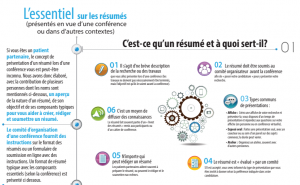Le français suit / French follows
By: Joletta Belton
One of the things I really enjoyed during the course of the PxP: Partnering to Make Research Stronger conference was the lively Zoom chat discussions that took place during the presentations. To see these chats for yourself, they have been summarized and anonymized and are available on the PxP Resource Hub.
There were also great questions asked in the Q&A, yet there wasn’t always time for those questions to be answered in depth. I particularly liked this question: “what is one thing you would like see changed after PxP?”
The answer for me came quickly: Building more relationships. Specifically relationship-building between researchers and people in the community who live with whatever it is that’s being studied. Relationships that are inclusive, diverse, and equitable, where power is shared (or power differentials are at least acknowledged and transparent) and everyone is valued for the unique knowledge, perspectives, skills, and experiences they bring.
The need for building and sustaining relationships was a common theme throughout all three days of the conference. Some important questions surrounding this theme include: where does this relationship building start? Who should initiate it? How can relationship-building between researchers and communities/people with health conditions be facilitated, resourced, supported, and sustained? Who is doing this well? Where can we improve?
In the first session to kick off PxP: Partnering to Make Research Stronger (https://youtu.be/Lf2TJmFRW24?si=1bEK92puH5h_rHRq), Angela Ruddock made the distinction between public contributors and community engagement. No one person can ever represent an entire group, and groups themselves are heterogeneous. As Angela said, ‘there’s no such thing as a homogenous community anywhere’. So when it comes to relationship-building we need to move beyond thinking in terms of just partnering with one person with pain on a particular study, to engaging and involving communities of people who can better represent the inherent diversity of experiences, backgrounds, perspectives, and insights.
“Go to where the people are at, develop a relationship with them.” Alma McCormick
This includes being sure to include all voices, as was discussed on day three (https://youtu.be/AC3zKsS37uU?si=CizLIO853V_VTjqv) and echoed what Angela said on day 1, that no group is ‘hard to reach’, they have been historically ignored and excluded. This exclusion can take the form of requiring patient partners and community members to come to the research, rather than the research going to the patient partners or into the community. Environments like the hospital, or health systems or academic systems and institutions, can actually be unsafe for some of these communities to come into, so there is a need for researchers to go into the communities to establish relationships and build trust.
Sandra Jayacodi asked, in the Including All Voices Session, ‘How about investing time and resources to building trust and relationship with communities?’ This sort of relationship building takes time, effort, and resources. We must avoid tokenism and embrace intersectionality and include and represent more diverse perspectives and peoples.
“Having funding that allows for pre-work and relationship building with communities. Funders for research have to proactively encourage and support inclusive research.” Sandra Jayacodi
It is so important that patient and public involvement and engagement in research is founded on strong, trusting relationships. This work needs be inclusive and representative, and certainly cannot be tokenistic. Relationship building takes investment of time, resources, and effort, but the payoffs are more than worth it.
S’il y a bien une chose que j’ai adorée de la conférence PxP Tisser des liens pour renforcer la recherche, ce sont les discussions animées du clavardage Zoom pendant les présentations. Si vous voulez y jeter un coup d’œil, elles ont été résumées et anonymisées sur la plateforme de ressources de PxP.
Les interrogations soulevées lors de la période de questions ont également été très pertinentes. Malheureusement, une réponse détaillée n’a pas pu être fournie pour chacune d’entre elles, faute de temps. J’ai toutefois trouvé cette question particulièrement intéressante : « Quel changement voudriez-vous voir à la suite de la conférence PxP? »
Pour ma part, la réponse m’est venue rapidement : nouer plus de relations. Surtout entre les chercheurs et les personnes de la collectivité qui vivent avec le problème ou la maladie à l’étude. Nous avons besoin de relations inclusives, diversifiées et équitables, où le pouvoir est partagé (ou encore où les différences de pouvoir sont au moins reconnues et transparentes) et où chacun est apprécié pour ses connaissances, ses perspectives, ses compétences et ses expériences uniques.
Le besoin de créer et d’entretenir des relations est un thème qui est revenu souvent lors des trois jours de la conférence. Parmi les questions importantes à ce sujet, mentionnons : par où commencer? Qui devrait entreprendre les démarches? Comment encourager, financer, soutenir et maintenir l’établissement de relations entre les chercheurs et les communautés ou personnes ayant des problèmes de santé? Sur qui prendre exemple? Quelles pistes d’amélioration explorer?
Lors de la première séance de la conférence PxP Tisser des liens pour renforcer la recherche (https://www.youtube.com/watch?v=Lf2TJmFRW24, en anglais seulement), Angela Ruddock a fait la distinction entre les collaborateurs du public et la participation communautaire. En effet, personne ne peut représenter un groupe en entier, et les groupes eux-mêmes sont hétérogènes. Comme l’a soulevé Angela, « une communauté homogène, ça n’existe pas ». Alors, lorsqu’il s’agit de créer des relations, il faut arrêter de collaborer avec une seule personne qui présente le problème à l’étude, et commencer à mobiliser et faire participer les communautés de gens pouvant mieux représenter la diversité inhérente aux expériences, aux horizons, aux perspectives et aux connaissances.
« Allons là où se trouvent les gens, et tissons des liens avec eux. » – Alma McCormick
Il s’agit notamment de veiller à inclure toutes les voix, comme mentionné à la troisième journée (https://www.youtube.com/watch?v=AC3zKsS37uU, en anglais seulement). Cette séance a également réitéré ce qu’avait mentionné Angela le premier jour, c’est-à-dire qu’aucun groupe n’est hors d’atteinte; c’est seulement que certains ont toujours été négligés et exclus. Par exemple, demander aux patients partenaires et aux membres de la communauté de venir à la recherche plutôt que l’inverse peut constituer une forme d’exclusion. Les membres de certaines communautés peuvent ne pas se sentir en sécurité dans des milieux comme les hôpitaux, les systèmes de santé ou les établissements d’enseignement. Il faut donc que les chercheurs se rendent dans les communautés afin de tisser des liens de confiance.
Lors de la séance Inclure toutes les voix, Sandra Jayacodi a posé la question suivante : « Pourquoi ne pas investir du temps et des ressources dans l’établissement de relations de confiance avec les communautés? » Ce genre de démarche demande du temps, des efforts et des ressources. Nous devons éviter la diversité de façade, appliquer l’intersectionnalité et inclure et représenter des points de vue issus d’une plus grande diversité de personnes.
« Il faut disposer d’un financement qui permet d’effectuer le travail préparatoire et d’établir des relations avec les communautés. Les bailleurs de fonds de la recherche doivent encourager et soutenir de façon proactive la recherche inclusive. » – Sandra Jayacodi
Il est crucial que la participation et la mobilisation des patients et du public en recherche reposent sur des relations de confiance solides. Les efforts se doivent d’être inclusifs et représentatifs, et ne peuvent se permettre d’être purement symboliques. Tisser des liens requiert temps, ressources et efforts, mais le jeu en vaut certainement la chandelle.


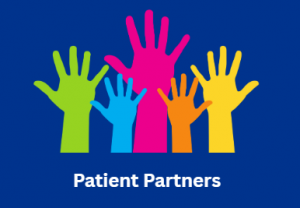

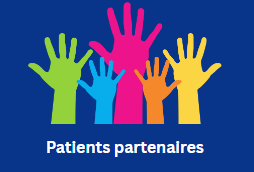
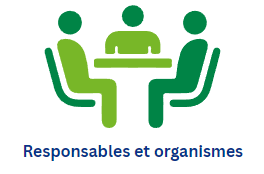
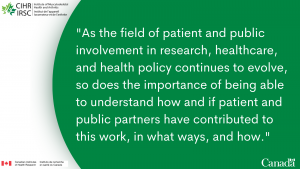



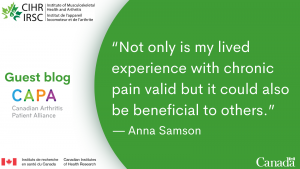
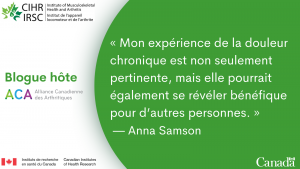

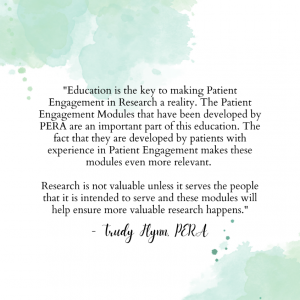

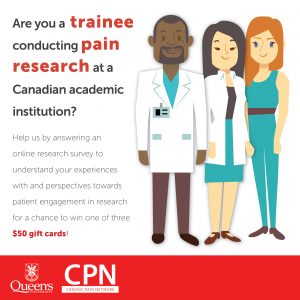


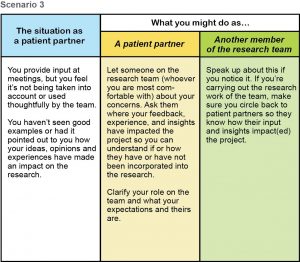


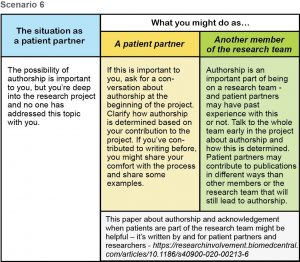 Download .pdf:
Download .pdf: 
